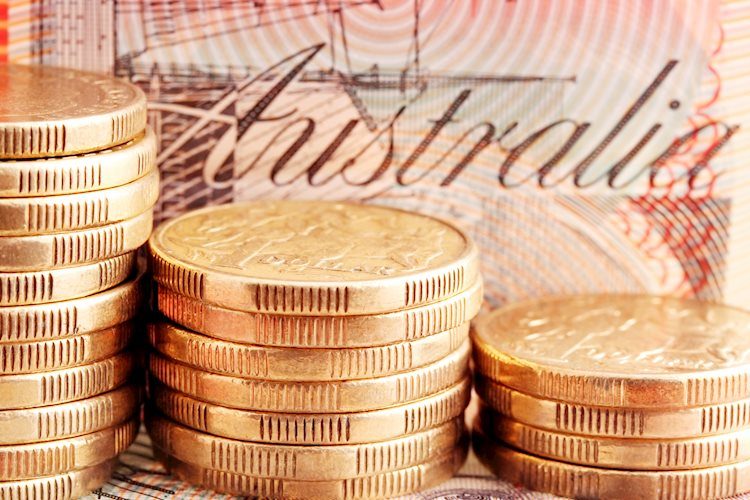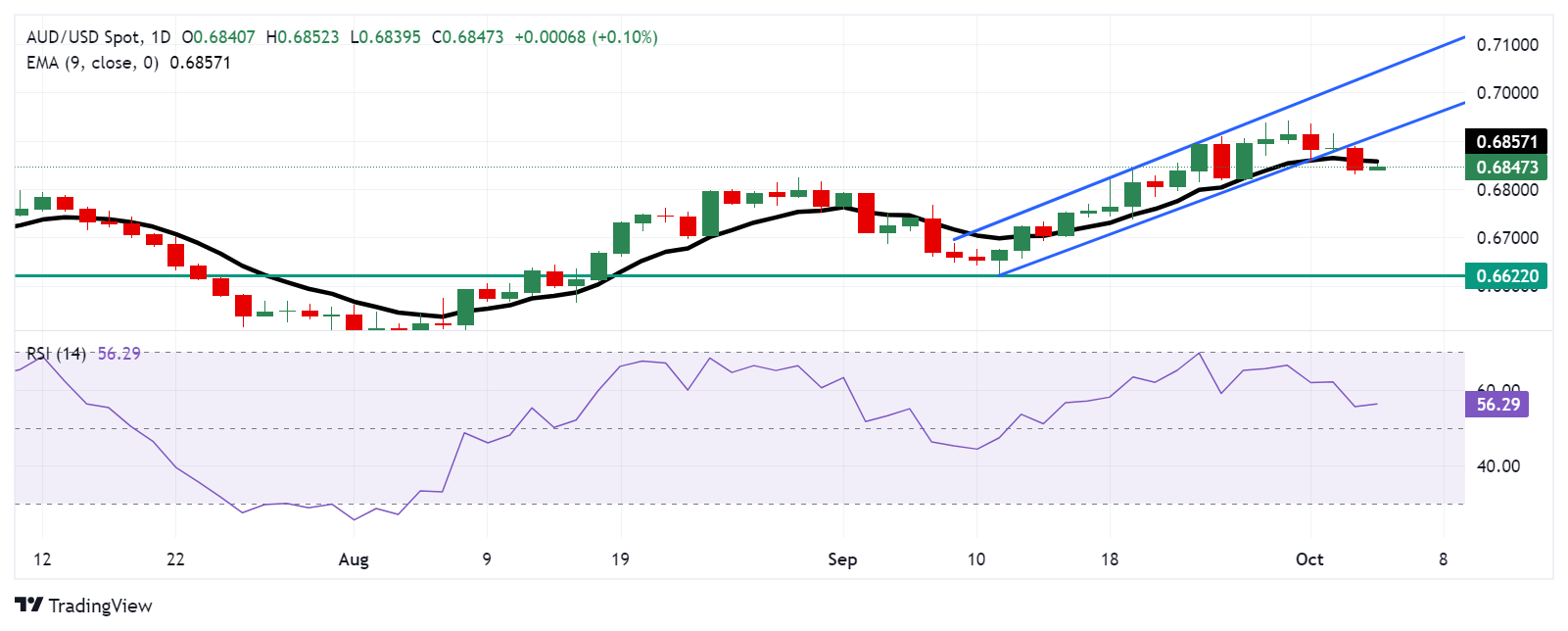
- The Australian Dollar appreciates as the RBA is widely expected to maintain its hawkish policy stance in November.
- The commodity-linked AUD receives support from stimulus measures in China, Australia’s largest trading partner.
- The risk-sensitive AUD/USD pair could struggle as US President Biden stated that Israel could strike Iran’s Oil infrastructure.
The Australian Dollar (AUD) gains ground due to the hawkish outlook surrounding the Reserve Bank of Australia (RBA). Recent data showed retail sales growth for August exceeding expectations, reducing the chances of an early rate cut from the RBA. Markets have nearly ruled out a rate cut in November. Furthermore, the AUD is benefiting from stimulus measures in China, Australia’s largest trading partner, which have lifted commodity prices.
The risk-sensitive AUD/USD pair could encounter headwinds as rising geopolitical tensions in the Middle East weigh on risk appetite. US President Joe Biden stated that the United States (US) is in discussions with Israel about potential strikes on Iran’s Oil infrastructure. Israeli Prime Minister Benjamin Netanyahu warned that Iran “will pay a heavy price” for Tuesday’s attack, which involved the firing of at least 180 ballistic missiles at Israel, according to the BBC.
The Australian Dollar came under pressure as the US Dollar (USD) gained strength following a better-than-expected US ISM Services PMI and ADP Employment Change reports, which challenged dovish expectations for Federal Reserve (Fed) monetary policy. Traders are now looking ahead to Friday’s US employment data, including Nonfarm Payrolls (NFP) and Average Hourly Earnings, for further direction.
Daily Digest Market Movers: Australian Dollar receives support from hawkish sentiment surrounding the RBA
- The CME FedWatch Tool indicates that markets are assigning a 67.4% probability to a 25 basis point rate cut by the Federal Reserve in November, while the likelihood of a 50-basis-point cut is 32.6%, down from 35.2% a day ago.
- Federal Reserve Bank of Chicago President Austan Goolsbee reiterated on Thursday that the interest rates need to come down over the next year by “a lot.” Goolsbee further stated that he’d like to keep the unemployment rate at 4.2% from rising any further.
- US ISM Services PMI rose to 54.9 in September, from 51.5 in August and exceeding the market forecast of 51.7. Meanwhile, the Services Prices Paid Index, a key inflation indicator, climbed to 59.4 from 57.3.
- Australia’s Trade Balance for August stood at 5,644 million month-over-month, surpassing market expectations of 5,500 million and slightly higher than July’s surplus of 5,636 million. However, both Exports and Imports declined by 0.2% month-over-month in August.
- Australia’s Judo Bank Services Purchasing Managers’ Index (PMI) posted a reading of 50.5 in September, down from 52.5 in August. This indicates the eighth consecutive month of growth in services activity, albeit at a slower and marginal rate. Meanwhile, the Composite PMI declined slightly to 49.6 in September, compared to 49.8 in the previous month, data showed on Thursday.
- Federal Reserve Bank of Richmond President Tom Barkin addressed the Fed’s recent rate actions on Wednesday, warning that the fight against inflation may not be over, as risks still persist. Barkin noted that the 50 basis points (bps) rate cut in September was justified because rates had become “out of sync” with the decline in inflation, while the unemployment rate was near its sustainable level.
- The ADP Employment Change report showed an increase of 143,000 jobs in September, surpassing the forecasted 120,000 jobs. Additionally, annual pay rose by 4.7% year-over-year. The total number of jobs added in August was revised upward from 99,000 to 103,000.
- On Monday, Federal Reserve (Fed) Chairman Jerome Powell said that the central bank is not in a hurry and will lower its benchmark rate ‘over time.’ Powell added that the recent half-point interest rate cut should not indicate similarly aggressive future actions, noting that upcoming rate changes are likely to be more modest.
Technical Analysis: Australian Dollar remains below 0.6850, nine-day EMA
The AUD/USD pair trades near 0.6840 on Friday. Technical analysis of the daily chart indicates that the pair is positioned below the ascending channel, signaling an emergence of a bearish bullish bias. However, a move back into the channel would reinforce the bullish sentiment, as the 14-day Relative Strength Index (RSI) remains above the 50 level, suggesting that bullish momentum is still present.
Regarding resistance, the pair could test the immediate nine-day Exponential Moving Average (EMA) at 0.6857 level, followed by the lower boundary of the ascending channel at 0.6910 level. A return to the ascending channel would reinforce the bullish bias and support the AUD/USD pair to explore the area around the channel’s upper boundary, at the 0.7040 level.
On the downside, the AUD/USD pair could target a psychological level of 0.6800. A break below this level could push the pair to navigate the region around its seven-week low of 0.6622, recorded on September 11.
AUD/USD: Daily Chart
Australian Dollar PRICE Today
The table below shows the percentage change of Australian Dollar (AUD) against listed major currencies today. Australian Dollar was the strongest against the Euro.
| USD | EUR | GBP | JPY | CAD | AUD | NZD | CHF | |
|---|---|---|---|---|---|---|---|---|
| USD | 0.06% | -0.02% | -0.34% | 0.02% | -0.05% | 0.02% | -0.06% | |
| EUR | -0.06% | -0.06% | -0.39% | -0.01% | -0.12% | -0.02% | -0.13% | |
| GBP | 0.02% | 0.06% | -0.31% | 0.05% | -0.05% | 0.03% | -0.09% | |
| JPY | 0.34% | 0.39% | 0.31% | 0.35% | 0.27% | 0.33% | 0.23% | |
| CAD | -0.02% | 0.01% | -0.05% | -0.35% | -0.08% | 0.01% | -0.13% | |
| AUD | 0.05% | 0.12% | 0.05% | -0.27% | 0.08% | 0.09% | -0.06% | |
| NZD | -0.02% | 0.02% | -0.03% | -0.33% | -0.01% | -0.09% | -0.14% | |
| CHF | 0.06% | 0.13% | 0.09% | -0.23% | 0.13% | 0.06% | 0.14% |
The heat map shows percentage changes of major currencies against each other. The base currency is picked from the left column, while the quote currency is picked from the top row. For example, if you pick the Australian Dollar from the left column and move along the horizontal line to the US Dollar, the percentage change displayed in the box will represent AUD (base)/USD (quote).
RBA FAQs
The Reserve Bank of Australia (RBA) sets interest rates and manages monetary policy for Australia. Decisions are made by a board of governors at 11 meetings a year and ad hoc emergency meetings as required. The RBA’s primary mandate is to maintain price stability, which means an inflation rate of 2-3%, but also “..to contribute to the stability of the currency, full employment, and the economic prosperity and welfare of the Australian people.” Its main tool for achieving this is by raising or lowering interest rates. Relatively high interest rates will strengthen the Australian Dollar (AUD) and vice versa. Other RBA tools include quantitative easing and tightening.
While inflation had always traditionally been thought of as a negative factor for currencies since it lowers the value of money in general, the opposite has actually been the case in modern times with the relaxation of cross-border capital controls. Moderately higher inflation now tends to lead central banks to put up their interest rates, which in turn has the effect of attracting more capital inflows from global investors seeking a lucrative place to keep their money. This increases demand for the local currency, which in the case of Australia is the Aussie Dollar.
Macroeconomic data gauges the health of an economy and can have an impact on the value of its currency. Investors prefer to invest their capital in economies that are safe and growing rather than precarious and shrinking. Greater capital inflows increase the aggregate demand and value of the domestic currency. Classic indicators, such as GDP, Manufacturing and Services PMIs, employment, and consumer sentiment surveys can influence AUD. A strong economy may encourage the Reserve Bank of Australia to put up interest rates, also supporting AUD.
Quantitative Easing (QE) is a tool used in extreme situations when lowering interest rates is not enough to restore the flow of credit in the economy. QE is the process by which the Reserve Bank of Australia (RBA) prints Australian Dollars (AUD) for the purpose of buying assets – usually government or corporate bonds – from financial institutions, thereby providing them with much-needed liquidity. QE usually results in a weaker AUD.
Quantitative tightening (QT) is the reverse of QE. It is undertaken after QE when an economic recovery is underway and inflation starts rising. Whilst in QE the Reserve Bank of Australia (RBA) purchases government and corporate bonds from financial institutions to provide them with liquidity, in QT the RBA stops buying more assets, and stops reinvesting the principal maturing on the bonds it already holds. It would be positive (or bullish) for the Australian Dollar.


